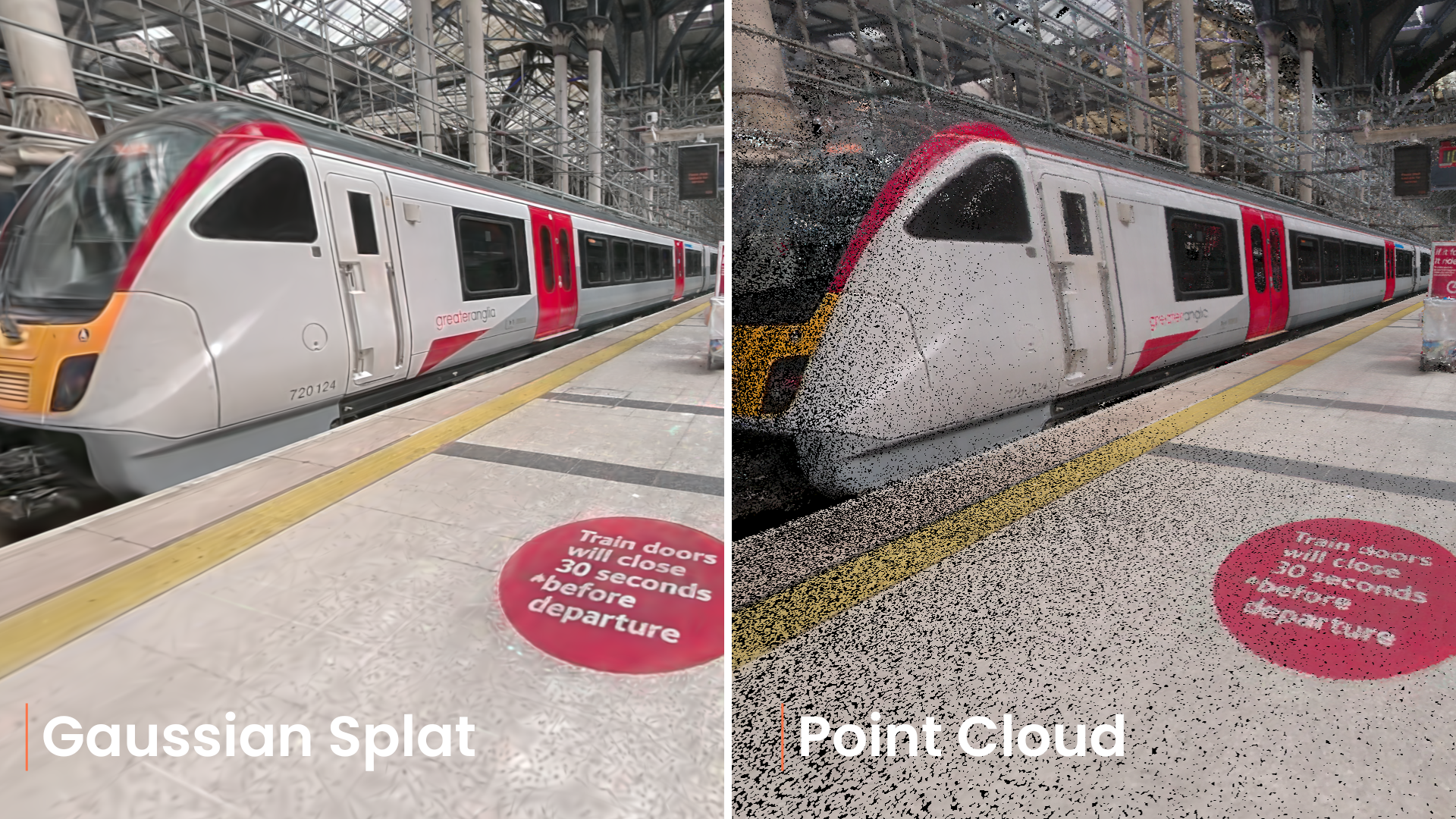
Technical
Gaussian Splatting Explained: Faster, Sharper Reality Capture than Point Clouds
An overview of Gaussian splatting, how it compares to point clouds, and where it delivers the best results.
Gaussian splatting creates detailed 3D models from images or video using thousands of overlapping 3D shapes—faster than traditional methods.
Point clouds map real-world surfaces using individual data points captured by scanners or cameras.
Accurate measurements rely on point clouds, but interpreting them can be challenging without survey expertise.
Using a gaussian splat alongside a point cloud model adds valuable photorealism to datasets.
Generate virtual tours with gaussian splatting—ideal for visual inspections and marketing campaigns.
Gaussian splatting is popular with many sectors including real estate, VFX, facilities management, and architecture.
See side-by-side comparisons of gaussian splatting and point clouds.
Over the last few years, gaussian splatting has become a major talking point in the reality capture field, with growing interest driven by its ability to quickly generate realistic 3D assets.
Gaussian splat model of Liverpool Street station
This technique creates detailed 3D models from images or video by blending thousands of overlapping shapes, delivering fast and highly realistic results with a straightforward workflow.
Processing with gaussian splats can often be completed in minutes, while traditional point clouds—built from collections of individual data points—can take hours or days and tend to produce visuals that are less lifelike.*
*Processing times vary depending on the size of the data set.
In this blog we explain what gaussian splatting is, how it compares to point clouds, and the best use cases for each, with data dataset comparisons will clearly highlight the differences between the two methods.
What is gaussian splatting?
Gaussian splatting is a method for creating and rendering 3D scenes from images or video, using collections of 3D Gaussians—essentially, blobs of data placed in space with different orientations and densities to match the look of real objects.
Each gaussian is defined by its position, colour, transparency, and shape. The technique uses neural rendering principles, enabling lifelike results without the heavy processing.
Gaussian splat of Newcastle Grainger Market
Unlike traditional methods such as point clouds or meshes, gaussian splatting produces a smooth, continuous scene that can be rendered directly. This approach stands out for its ability to create realistic lighting and reflections—something point clouds and meshes often struggle to achieve.
Side-by-side comparison of a gaussian splat and point cloud data sets
Gaussian splatting is particularly useful for capturing and reconstructing real-world scenes and is now gaining popularity for tasks similar to Neural Radiance Fields (NeRF), but with greater rendering efficiency.
Top benefits of gaussian splats at glance:
Enables real-time rendering of complex scenes.
Delivers photorealistic results with fine detail and realistic lighting.
Dynamically scales to high resolutions, supporting large environments.
Produces smooth, seamless models ideal for animation and visualisation.
Adapts easily to various data types, including point clouds and images.
Gaussian splatting vs traditional point cloud models
Point clouds and gaussian splats are both valuable tools in 3D reality capture, but they serve different needs across various industries.
Here’s a quick comparison of their key features.
Feature | Point Clouds | Gaussian Splatting |
|---|---|---|
Data Structure | Individual data points | Overlapping 3D Gaussians (‘splats’) |
Visual Quality | Can appear sparse or ‘dotty’ | Smooth, continuous, photo-realistic |
Processing Time | Slower; requires further processing | Faster; renders directly from images/video |
Best For | Measurement, mapping, engineering | Visual inspections, virtual tours, VFX |
Ease of Use | Requires expertise to interpret | More intuitive and user-friendly |
Lighting & Effects | Limited | Realistic lighting and reflections |
Gaussian splats can be generated quicker and render more photorealistic visuals, but they cannot match the precise measurement accuracy of point cloud models.
Point clouds are sets of data points in three-dimensional space, typically captured by 3D scanners, LiDAR, or photogrammetry. Each point’s exact x, y, and z coordinates map the surfaces of real-world objects or environments.
This accuracy makes point clouds the standard for measurement, mapping, surveying, and construction. Surveyors and engineers rely on point clouds for topographic surveys, construction site monitoring, and civil engineering projects where detail down to the millimetre is critical.
Point cloud model with measurement data displayed
Point clouds also integrate well with CAD software, supporting the creation of detailed models for design, planning, and inspection.
In contrast, gaussian splatting excels when photorealistic visuals and smooth navigation are key. It renders lifelike models quickly and can convincingly replicate lighting effects, making it ideal for applications such as virtual walkthroughs in real estate, immersive marketing tours, or visual inspections in industrial settings.
For example, our survey team created a highly detailed, colour-accurate 3D reconstruction of Ryhope Engines Museum by combining ground data from the XGRIDS Lixel K1 mobile laser scanner with aerial mapping from the DJI Matrice 4E.
This Aerial-Ground Map Fusion approach boosts 3DGS outputs, improving spatial accuracy, capturing roof details, and delivering complete, realistic reconstructions.
The handheld XGRIDS scan took just 30 minutes—two loops outside and a walkthrough inside—while drone data was collected following XGRIDS guidance for gaussian splatting, streamlining the workflow and enhancing results.
Gaussian splat of inside Ryhope Engines Museum
Gaussian splat of Ryhope Engines Museum
Gaussian splatting is also gaining popularity in film, TV, and public safety, where realistic scene reconstructions provide valuable context for production and investigations.
Overall, point clouds are preferred for technical precision and detailed analysis, while gaussian splatting offers major advantages for speed, realism, and visual communication.
Capturing and processing the data
The data collection methods for gaussian splatting and point clouds are both highly versatile. You can use drones, camera payloads, and handheld scanners for either technique, and with gaussian splats, it’s even possible to capture data using your phone.
We’re going to focus on XGRIDS and DJI compatibility.
Collecting and processing with XGRIDS kit
Handheld scanners like the XGRIDS Lixel K1 or Lixel L2 Pro are suited to gathering data for both point clouds and gaussian splats.
Once collected, data is processed in XGRIDS Lixel Cyber Colour (LCC) Studio software using the ‘Pointcloud & LCC’ function. After processing, you can export datasets as gaussian splats (LCC,PLY) or meshes (OBJ) for further use.
With this software, gaussian splat models are lightweight and easy to share—anyone with the link can view them without needing specialist software.
Point cloud models, however, are much larger files and cannot be shared in the same way—they can only be viewed within the platform itself.
Collecting and processing with DJI tech
DJI Terra supports processing data from DJI aircraft to generate both gaussian splatting and point cloud models.
DJI Terra has launched v5.0.0 which supports gaussian splatting, allowing users to generate photorealistic, high precision 3DGS models from drone data.
The basic 3D reconstruction workflow involves importing data, running aerotriangulation, and generating the 3D model. Aerotriangulation—essential for both 2D and 3D outputs—can be performed as a separate step or integrated within the reconstruction process.
For point clouds, drones such as the Matrice 400 or Matrice 350/300 with the Zenmuse L2 (LiDAR) or P1 (photogrammetry) payloads collect data, which is then processed in DJI Terra to produce high-accuracy models for mapping, measurement, and survey work.
LiDAR point cloud model created with DJI Terra
Consumer drones like the Air 3, Mini 4 Pro, and Mavic 3 Pro are also suitable for smaller projects.
Using gaussian splatting and point cloud models together
Gaussian splats and point clouds can be combined—point clouds provide the measurement accuracy needed for engineering, while gaussian splats deliver visual clarity for presentations and communication.
This hybrid approach enables teams to showcase accurate, immersive 3D environments while retaining precise spatial data.
A great example if this in action is the transformation of railway infrastructure monitoring using the XGRIDS Lixel L2 Pro handheld scanner.
At London’s Liverpool Street Station, the heliguy™ survey team conducted a single survey to capture both a photorealistic gaussian splat and a true-colour point cloud, all without the need for extra hardware.
The team processed the data in XGRIDS Lixel CyberColor Studio and created visualisations in NUBIGON, clearly demonstrating how combining these techniques delivers both technical accuracy and striking visual results.
Ken Durling, asset engineer at Network Rail, praised the capture method and sees significant benefits for the wider rail industry.
Summary
Overall, point clouds are still the benchmark for precise measurement and technical analysis. However, gaussian splatting is rapidly emerging as the preferred choice for photorealistic visualisation and immersive virtual experiences.
To learn more about gaussian splatting, XGRIDS kit, or DJI Terra, contact our survey team. Our GIS specialists can guide you from consultation to data processing support and help you implement the best solution for your needs.
